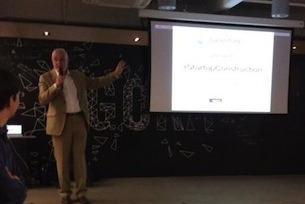Kick in the Door: It’s Time to Digitise
Visualise technology being used at Construct//Disrupt in June
Change is coming
The government has mandated that all of its projects employ BIM by 2016. Yet according to the Software Advice BuyerView Survey, a company that helps buyers connect with construction software vendors, 52% of us still rely on pen and paper for our daily operations. So how do we initiate the move from tradition to disruption? Firstly, we need to identify what we are moving towards.
What is BIM?
The UK Government defines BIM as “a collaborative way of working, underpinned by the digital technologies which unlock more efficient methods of designing, creating and maintaining our assets”. In essence, BIM encompasses so much more than just digitising current processes – that’s the means but is not the end. Improving and increasing collaboration and the sharing of data is the endgame of BIM, which can be facilitated with effective construction software. Big Data has revolutionised so many other spheres – why not ours?
Real savings in real time
BIM’s core focus is to improve our industry. Despite this, more than half of us still cling to traditional pen and paper use in order to get work done. We are not only creating more work for ourselves, we are also wasting time, money, and valuable resources. According to the U.K. government, £804m was saved in 2013 and 2014 largely due to the use of BIM on projects. Digital Built Britain is real and has tangible savings for the firms that realise this. How do we convince those that have not yet digitised that the benefits far outweigh the costs? How do we cross the chasm into the twenty-first century?
Adopting innovation
In a world where technology has made it possible to share information and data at the click of a button, the industry cannot afford to remain stagnant. Construction is at an impasse; digitise or risk being left behind. The question now is how do we move along the Technology Adoption Curve, to diffuse new innovations and ways of working across organisations?
As with any change, there will be resisting forces. The Software Advice survey found that one of the biggest barriers to the investment in construction software is the perceived learning curve for users. Mindlessly digitising is not the point; engaging and empowering individuals at all levels of the organisation and the supply chain is.
This emphasises the importance of the roles of BIM managers, coordinators and champions. The industry needs them to foreground user-friendly technologies and empower individuals to work more efficiently and collaboratively. Ground-up adoption of new technologies is key to the diffusion of innovation and BIM managers have a key part to play in this.
What does all this mean for me?
The construction industry is evolving. Technology has given us the ability to reach heights we could have never imagined thirty years ago. By 2016 all public sector projects will use BIM. Positive change is coming, but only with the collaboration of people can we hope to truly advance as an industry. It falls to BIM managers, coordinators, and thought-leading engineers and architects to drive this change. Innovation is on the horizon, the time to implement is now.
Keep your finger on the pulse by joining our innovators group where we share the latest innovations in the built environment.
Subscribe to our blog




